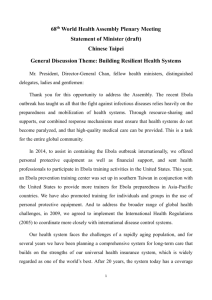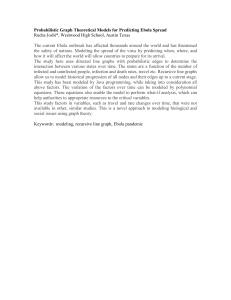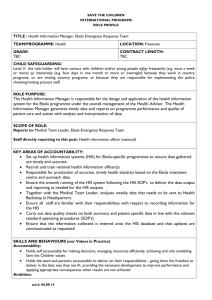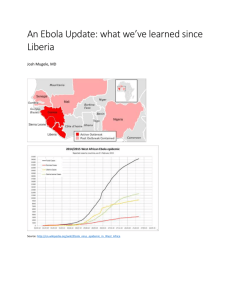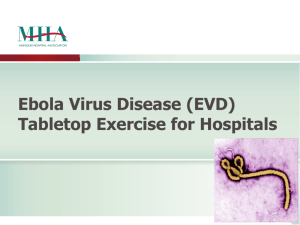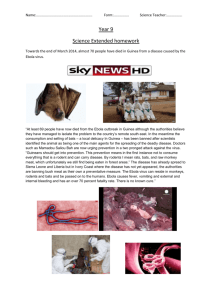Region 6 Ebola Symposium PowerPoint
advertisement
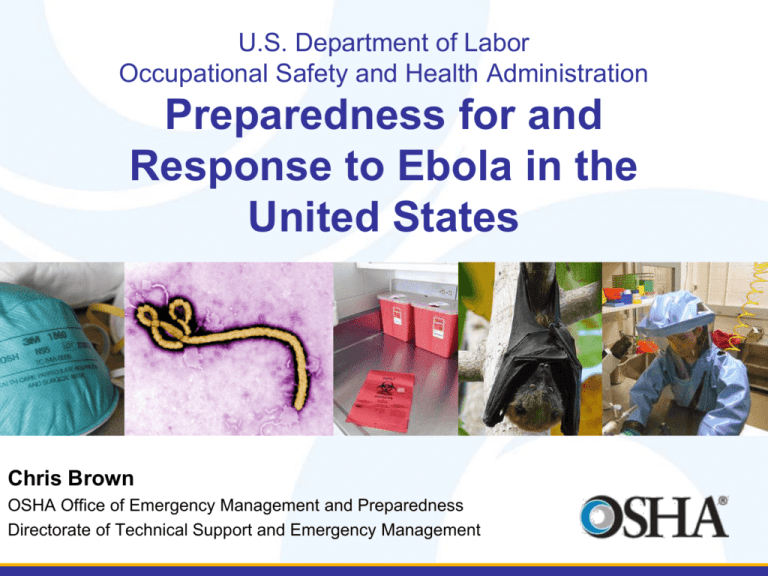
U.S. Department of Labor Occupational Safety and Health Administration Preparedness for and Response to Ebola in the United States Chris Brown OSHA Office of Emergency Management and Preparedness Directorate of Technical Support and Emergency Management 2 Overview • Current Ebola outbreak – Latest case counts • OSHA response – Coordinated efforts with other federal departments and agencies – Stakeholder and field engagement 3 Current Ebola Outbreak • The 2014 Ebola epidemic is the largest in history, affecting multiple countries in West Africa. • First reports of an outbreak in West Africa surfaced in March 2014. • Two imported cases of Ebola virus disease (EVD), including one death, and two locally acquired cases in healthcare workers, have been reported in the United States. • There are currently no confirmed Ebola Virus Disease (Ebola) cases in the U.S. 4 Current Ebola Outbreak • CDC world-wide case counts as of March 6, 2015 – Total Cases: 23,014 – Laboratory-Confirmed Cases: 14,379 – Total Deaths: 9,840 • U.S. (now considered “previously affected”) – Total Cases: 4 – Laboratory-Confirmed Cases: 4 – Total Deaths: 1 Note: Total case counts updated in conjunction with the World Health Organization updates and are based on information reported by the Ministries of Health. 5 U.S. Cases • Three confirmed cases in Dallas, TX, in September/October 2014. • Oct. 23, 2014 - The New York City Department of Health and Mental Hygiene reported a case of Ebola in a medical aid worker who had returned to New York City from Guinea, where the medical aid worker had served with Doctors Without Borders (MSF). – Diagnosis confirmed by CDC on October 24. – Patient recovered and was discharged from Bellevue Hospital Center on Nov. 11, 2014. 6 Federal Response • OSHA stood up outbreak preparedness and response efforts beginning in July 2014, well ahead of U.S. cases. • Technical assistance and support for other federal agencies • Assistance in protecting workers who may have occupational exposure • Coordinating closely with CDC/National Institute for Occupational Safety and Health (NIOSH) to issue worker protection guidance 7 Federal Response • CDC leading the USG response – Emergency Operations Center has been staffed for more than 240 days – 300+ USPHS & CDC staff conducting support missions 8 Federal Response • Other federal agencies involved – DHS: Screening of incoming travelers at points of entry – Check for symptoms, risk factors – 5 major U.S. airports: ATL, JFK, EWR, IAD, ORD 9 Federal Response • Other federal agencies involved – DOD: military personnel were deployed to help build Ebola treatment centers in Africa – DOT: FAA working to ensure safety of flight crews who may encounter passengers traveling from Ebola-affected countries – EPA: responsibilities for waste processing and disposal – NIH: providing guidance through NIEHS, treatment of patients at NIH – Others beyond those mentioned 10 Workers at Risk of Exposure to Ebola Workers in healthcare settings • • • • • • Direct patient care (doctors, nurses, technicians) Laboratory workers (research, diagnostics / analysis) Environmental services (housekeeping, laundry) Facility management / Building engineering Waste handlers / Decontamination personnel Emergency responders (e.g., EMS) Workers in non-healthcare settings • Persons handling the deceased • Airline workers (airline cabin service workers, including cleaning crews, for flights originating from the countries named by CDC as having Ebola outbreaks) and other transportation industry workers • Waste workers involved in other cleaning/decontamination operations • Customs officers / Border patrol employees • Other law enforcement personnel 11 Workers at Risk of Exposure to Ebola Workers in healthcare settings may be exposed during: • Evaluation of patients in ED • Treating confirmed or suspected EVD patients • Performing medical procedures that generate aerosols • Cleaning and decontamination • Handling waste 12 Workers at Risk of Exposure to Ebola Workers in laboratories may be exposed during: • Handling, testing, storing, and disposing of samples from patients with EVD • Opening sample tubes • Vortexing sample tubes • Other procedures that result in splashes, sprays or aerosols containing Ebola virus particles • Working near other workers conducting hazardous procedures 13 Workers at Risk of Exposure to Ebola Workers in waste handling may be exposed during: • Collection of waste • Packaging of waste • Transport of waste • Processing/treatment of waste – Autoclaving – Rotoclaving Not typically a hazard: • Disposal of treated waste, incinerator ash, etc. Source: Tempico Manufacturing, Inc. 14 Workers at Risk of Exposure to Ebola Workers in transportation sector may be exposed during: • Interacting with travelers/ passengers • Handling contaminated cargo • Cleaning transportation vehicles and facilities Public domain photos Applicable OSHA Standards • Bloodborne Pathogens (29 CFR 1910.1030) • Personal Protective Equipment (29 CFR 1910.132 (general), .133 (eye/face), .138 (hand)) • Respiratory Protection (29 CFR 1910.134) • Hazard Communication (29 CFR 1910.1200 • Access to Employee Medical Records (29 CFR 1020) • Recording and Reporting occupational Injuries and illnesses (29 CFR Part 1904) • General Duty Clause (section 5 (a)1 of OSH Act) • Visit www.osha.gov/ebola for more 15 16 Bloodborne pathogens included under the BBP Standard • • • • • • Hepatitis B &, C and HIV Syphilis Malaria Babesiosis Brucellosis Viral hemorrhagic fevers including Ebola, Lassa, Marburg and Crimean-Congo fevers 17 The BBP Standard covers: • Reasonably anticipated contact with blood or other potentially infectious materials (OPIM) • OPIM includes – other body fluids such as semen, vaginal secretions, pleural fluids – body fluids contaminated with blood and – body fluids where it is difficult or impossible to differentiate between body fluids. 18 The BBP Standard requires employers to: • • • • Conduct an written exposure assessment Develop a written exposure control plan Involve workers in development of the plan Implement a program of engineering controls, safer work practices, and PPE to protect workers • Provide workers with initial and periodic training, including about PPE, that is interactive and in a language/format they can understand • Keep certain types of medical, training, and injury/exposure records 19 OSHA Ebola Activities • Coordination with federal and state partners • Outreach to other stakeholders • Development of technical support resources and guidance materials • Technical assistance in the field 20 Federal interagency coordination • CDC/NIOSH – Development of worker safety and health guidance – Regularly schedule incident management updates • White House – Office of Science and Technology Policy PPE research – Waste handling, treatment, and disposal • HHS/NIEHS, /CDC/NIOSH, and /ASPR – Development and delivery of training for health care workers (HCWs) and workers in other sectors 21 Federal interagency coordination • HHS/CDC/NIOSH, EPA, and DOT (and labor and industry reps) – OSHA-led Ebola waste management workgroup to develop interagency guidance document related to worker health and safety in medical waste handling, collection, transport, treatment and disposal. • HHS/ASPR, /FDA, /CDC/NIOSH – Interagency group to discuss status of the PPE supply chain for the Ebola response • DHS – Development of health and safety aspects of screening protocols for border and transportation screening workers 22 Federal interagency coordination • DOT/FAA & HHS/CDC/NIOSH – Safety and health issues for flight crews – Technical assistance regarding PPE, infection control, and isolation methods aboard aircraft • Veterans Affairs (VA) – Development of health and safety aspects of PPE protocols for HCWS • Institute of Medicine (IOM) – Presentation of information about PPE and other worker safety and health topics related to Ebola 23 State coordination • Technical assistance to State Plans and other state agencies, as requested • Guidance document reviews • Development of internal wiki-style “OSHAPedia” page accessible to federal, State Plan, and consultation staff 24 Other stakeholder outreach • Public – Development and publication of guidance materials – Responding to calls, emails, letters, and ECorrespondence from workers, employers, the general public, and other stakeholders • Labor unions and industry representatives – Union engagement and worker/employer preparedness activities – Compliance assistance meetings and symposia – Discussions with employers across multiple sectors – Development and publication of guidance materials 25 OSHA’s Ebola Webpage http://www.osha.gov/ebola/ Ebola Fact Sheets • “Cleaning and Decontamination of Ebola on Surfaces” • Provides guidance for workers and employers in nonhealthcare and non-laboratory settings 26 Ebola Fact Sheets • “Safe Handling, Treatment, Transport, and Disposal of EbolaContaminated Waste” • Jointly developed with NIOSH and EPA to address challenges in U.S. waste stream 27 OSHA/NIOSH Fatigue Guidance • “Preventing worker fatigue among Ebola healthcare workers and responders” • Covers assessment of work load, training, rest, etc. 28 OSHA PPE Selection Matrix 29 30 Hospital Preparedness • Coordination and information sharing between CDC/NIOSH, fed OSHA and State Plans • OSHA Regional staff visits to U.S. hospitals to assess and improve preparedness – Treatment hospitals (35) – highest priority – Assessment hospitals – next highest priority • OSHA focus during Ebola hospital visits – Technical assistance/support role – Listening to and observing workers – Sharing best practices and lessons learned Questions? Feel free to contact the OSHA Office of Emergency Management and Preparedness with any additional questions: Chris Brown Office of Emergency Management and Preparedness Directorate of Technical Support and Emergency Management Phone: (202) 693-2300 brown.christopher.k@dol.gov

